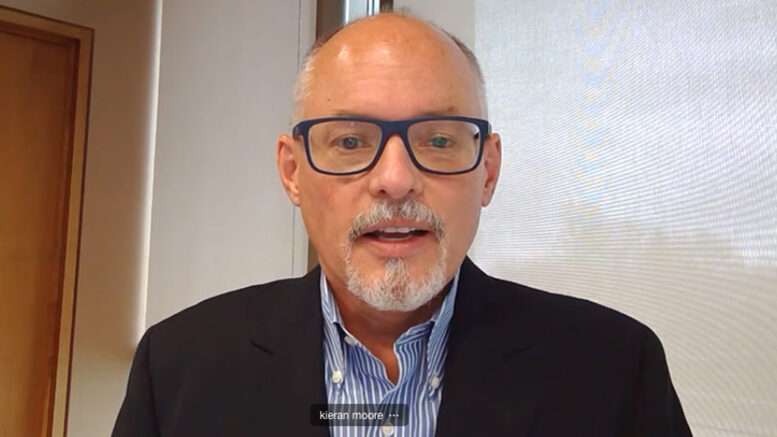Adam Prudhomme
Editor
KFLA Public Health Medical Officer of Health Dr. Kieran Moore noted the region is starting to trend in the right direction in terms of COVID-19 numbers, but they’re still not where they need to be.
Moore spoke to local reporters via Skype on Thursday in what has become a weekly occurrence, once again covering a range of topics.
“Our rate of illness is 43.6 per 100,000,” said Moore. “That’s still higher than I’d ever like to see, be relative to the rest of the province we’re not doing too badly.”
While better than most regions, Moore says residents must continue to follow Public Health’s best practices.
“Our risk has never been higher in the community,” said Moore. “Travelling right now outside of the region, the rates go up four, five, six times than we’re currently experiencing. So please adhere to the stay local, support local, stay to you household as best you can because that will keep you safer during this very treacherous, dangerous time of April and it seems like it’s going to be heading into May for the rest of the province as well. We’re watching our numbers very closely, our team is working very diligently to try to isolate cases, quarantine individuals who are at risk. Our system locally is working very well, we’re not overwhelmed but certainly other areas of the province have never experienced this high of a case count and so please stay local, support local, don’t travel outside our region.”
As the province re-configures the amount of vaccines that get distributed to each health unit, Moore says he supports sending more doses to COVID-19 hot spots. That means KFLA will see few doses over the coming weeks, but Moore says this region is still among the highest vaccinated while still being among the lower risk regions.
“I would absolutely understand if they had to use some of the vaccine now for the highest risk areas of the province,” said Moore. “The case counts are just way, way too high and too many patients are in hospital today. From our vantage point we have a steady state supply. At the end of this month we’ll have a reduction somewhat in our Pfizer line but we haven’t overbooked our clinics. We don’t expect that we’ll have to cancel anyone’s appointments for our mass immunization clinics. Our pharmacies locally have received over 2,000 doses of AstraZeneca this week and have been immunizing as well. I was very happy to receive that extra dose of vaccine. At present we’re at 32 per cent of our adult population has had their first vaccine, which is an exceptionally good number for Ontario. I’m happy to celebrate that 95 per cent of our over 80 population have had their first dose and 12 per cent of that population have had their second dose and are fully protected.”
With Premier Doug Ford expected to announce more restrictions today, Moore says he’d like to see stricter enforcement of the rules currently in place. If the numbers continued to rise despite enforcement, he says then it would be time to look at what has worked in other parts of the world, in particular a 10 p.m. curfew as well as travel restrictions to hot spots such as the GTA.
On the subject of virtual schools, he says he hopes the province will take a regional approach once COVID-19 numbers start to decline.
“”Our preference from a Public Health stand point is always to have our children in school,” said Moore. “From a mental, physical, social health vantage point that absolutely is our preference. The decision to move to virtual was a decision by the Ministry of Education. We weren’t consulted at a local level. I do not know frankly if we’ll have a regional approach to this if Ontario gets their risk down, their case counts down. We are now trending in a better direction but still at 43.6 per 100,000 have too much infection in the community. We’re looking every single day of the percentage of tests done in children and their positivity rate and it appears to be very low in our region, one per cent or less. That has been a fairly state number. We’re not seeing the risk in the children go up. Only in adults our risk is going up. If we want our schools to get back to normal, we as a community, really it’s a challenge to everyone, to get our case counts down and stay home as much as you can.”
Moore says if KFLA can show the ministry that it is a safe community, ideally kids would be allowed to return to school.
Despite the recent rise in cases and variants of concern, Moore still believes things will start to return to normal by the autumn. He points to events in the U.S. such as a capacity crowd during the Texas Rangers home opener and the Masters as to what Canadians can look forward to in the near future.
“The risk of transmission once you’re immunized is much, much less,” said Moore. “I was envious of (fans at U.S. sporting events) but we will get there. I think it’ll be in the fall. We have an awful April and May to get through but after that we’re going to continue to build our immunization strategy for the protection of the community and the fall does look much, much better.”

